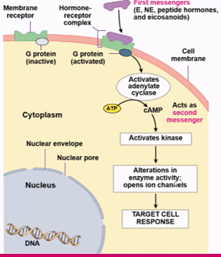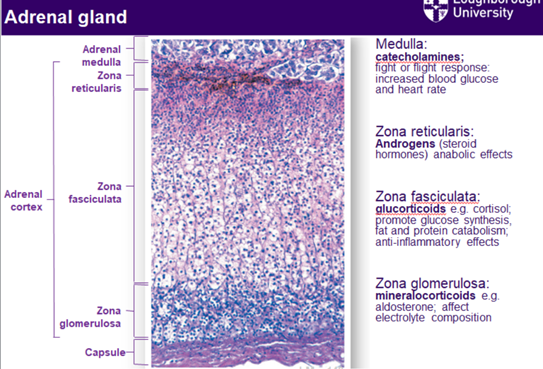Endocrine system
1/55
There's no tags or description
Looks like no tags are added yet.
Name | Mastery | Learn | Test | Matching | Spaced |
|---|
No study sessions yet.
56 Terms
What are the functions of the endocrine system?
Regulate long term growth
Regulate development
Regulate reproduction
What are hormones?
Chemical messengers which travel in the blood stream used by the endocrine system
How is an endocrine gland structured?
Ductless gland made of endocrine cells
Have good blood supply
Secrete hormones into the blood stream
How do hormones work?
They bind to the receptors (binding sites) in the target cells (cells with receptors)
This stimulates gene expression or protein synthesis to control physiological functions
What is a hormone receptor?
Protein located in or on a cell surface which binds to a specific hormone
What is the target cell?
A cell with a binding site containing a hormone receptor
What are anabolic steroid hormones?
Hormones which have receptors in muscles which stimulate muscle protein production
What are the 3 hormone types?
Amino acid derivative
Peptide derivative
Lipid derivative
What are amino acid derivative hormones?
Small molecules, similar structure to amino acids
What are peptide derivative hormones?
Consists of a chain of amino acids, the largest hormone
What are lipid derivative hormones?
Fat soluble hormones
Which types of hormones are lipid soluble?
Thyroid and steroid hormones
What is the dissolvability of lipid hormones?
Good for cell membranes, bad for bloodstream
What is the dissolvability of water hormones?
Good for bloodstream, bad for cell membrane
What location can hormone receptors be?
Cell membrane = This triggers G proteins on the cell membrane surface. This then activates second messengers within the cell, which alters the cell activity
Inside the cell = includes all receptors for thyroid and steroid hormones
How does hormonal action through cell membrane receptors work?
Hormone has a receptor on the cell membrane, which is bound to an inactive G protein
This activates the G protein, which activates enzyme adenylate cyclase
Adenylate cyclase converts ATP into cAMP, which is a secondary messenger
cAMP activates kinase enzymes, affected the cell

How does hormonal action through intracellular receptors work (STEROID)?
Hormone diffuses into the cell through the membrane, binding to a receptor
The hormone receptor complex binds to DNA in the nucleus
This activates genes which increases transcription rates
This increases mRNA production, leading to increase translation and protein synthesis

How does hormonal action through intracellular receptors work (THYROID)?
Same steps as steroid hormones, but the mitochondria also have hormone receptors
This increases ATP production
What 2 things can happen to hormones after secretion?
Free hormone = either bind to target cell receptor or broken down
Steroid + Thyroid = remain in circulation and require special transport proteins
What is the hypothalamus?
Interface between nervous and endocrine system
Has regulatory hormones which affect pituitary function
How does the hypothalamus regulate activity?
Production of oxytocin and ADH, which is passed down to the posterior pituitary
Secretion of hormones to control activity of anterior pituitary
Neuron travel down the preganglionic motor fibres to the adrenal gland to stimulate production of catecholamines
What is the structure of the pituitary gland?
Anterior lobe = made of endocrine cells
Posterior lobe = made of neural tissue
Separated by the pars media
What does the posterior pituitary lobe release?
ADH and oxytocin
What does the pars media release?
MSH
What does the anterior pituitary lobe release?
Pituitary hormone
What are some examples of the hypothalamus providing homeostasis?
Prolactin = use of PRF and PIF
Growth hormone = use of GH-RH and GH-IH
Where is growth hormone produced and what is its function?
Anterior pituitary lobe
Acts on the liver to promote the release of somatomedins, stimulating tissue growth and increased protein synthesis
This stimulate cell division in epithelial and connective tissue, stimulating liver glycogen breakdown triglyceride breakdown in adipocytes
Where is ADH produced and its function?
Produced in posterior pituitary lobe and secreted by osmoreceptors
Reduces fluid loss by increasing reabsorption, increasing blood pressure and volume
What is the function of the pineal gland?
Contains pinealocytes which secrete melatonin
Melatonin affects the circadian rhythm
What is the function of the thyroid gland?
Stores thyroid hormones T3 + T4
This increases sodium potassium ATP production
What effects do thyroid hormones have?
Increase HR
Increase O2 and energy consumption
Stimulates RBC production
Increase sensitivity to SNS
Increases bone turnover
What is the structure of a thyroid follicle?
Spherical unit filled with colloid
Lined by cuboidal epithelial cells
Surrounded by capillaries for iodine uptake and hormone release
How do thyroid follicles produce T3 and T4?
Follicular cells synthesise thyroglobulin and transport iodine into the colloid
Iodine binds to thyroglobulin → forms T3 and T4
What are C cells?
Produce calcitonin which is important in calcium homeostasis
They reduce serum calcium, which increases bone formation
What happens when calcium levels are low?
Detected by parathyroid hormone (PTH)
Stimulates osteoclasts to breakdown bones to release calcium into bloodstream
Increases production of calcitriol, increasing the absorption of calcium in the digestive system
Where is the parathyroid gland?
Small gland on the posterior of the thyroid gland
What does the adrenal medulla produce?
Catecholamines e.g. adrenaline
What does the adrenal cortex produce?
Steroid hormones

What does the zona reticularis produce?
Androgens, which provide an anabolic effect?
What does the zona fasciculata produce?
Glucocorticoids, which promote glucose synthesis, breakdown fat and protein
What does zona glomerulosa produce?
Produces mineralocorticoids, which effect electrolyte balance in the body
What is the pancreatic acini?
Exocrine cells which secrete hormones into the digestive tract
What is the pancreatic islet made up of?
2 types of endocrine cells:
Alpha cells
Beta cells
What do pancreatic alpha cells do?
Produce glucagon and increase blood glucose level
What do pancreatic beta cells do?
Produce insulin and reduce blood glucose levels
What jobs does insulin do?
Moves glucose from the blood into the cells to reduce blood glucose levels
Increases glycolysis rates,
Conversion of glucose to glycogen
Increase protein synthesis and amino acid absorption
What jobs does glucagon do?
Stimulates breakdown of glycogen and fatty acids
What is diabetes mellitus?
Disease where blood glucose levels are abnormally high
What is type 1 diabetes mellitus?
When pancreatic insulin production is inadequate
Requires an insulin pump
What is type 2 diabetes mellitus?
Caused by reduced tissue response to insulin
Can be managed by exercise and diet
What are the aims of growth hormones?
Stimulate protein synthesis and cell growth
What are the aims of thyroid hormones?
Nervous system development
What are the aims of insulin hormone?
Supply of energy and nutrients
What are the aims of parathyroid and calcitonin?
Calcium absorption and deposition in bones
What are the aims of reproductive hormones?
Cell growth and differentiation, and secondary sexual characteristics
What is the exhaustion phase?
The collapse of vital systems including:
Exhaustion of lipid reserves
Inability to produce glucocorticoids
Failure of electrolyte balance
Structural and functional damage of vital organs